
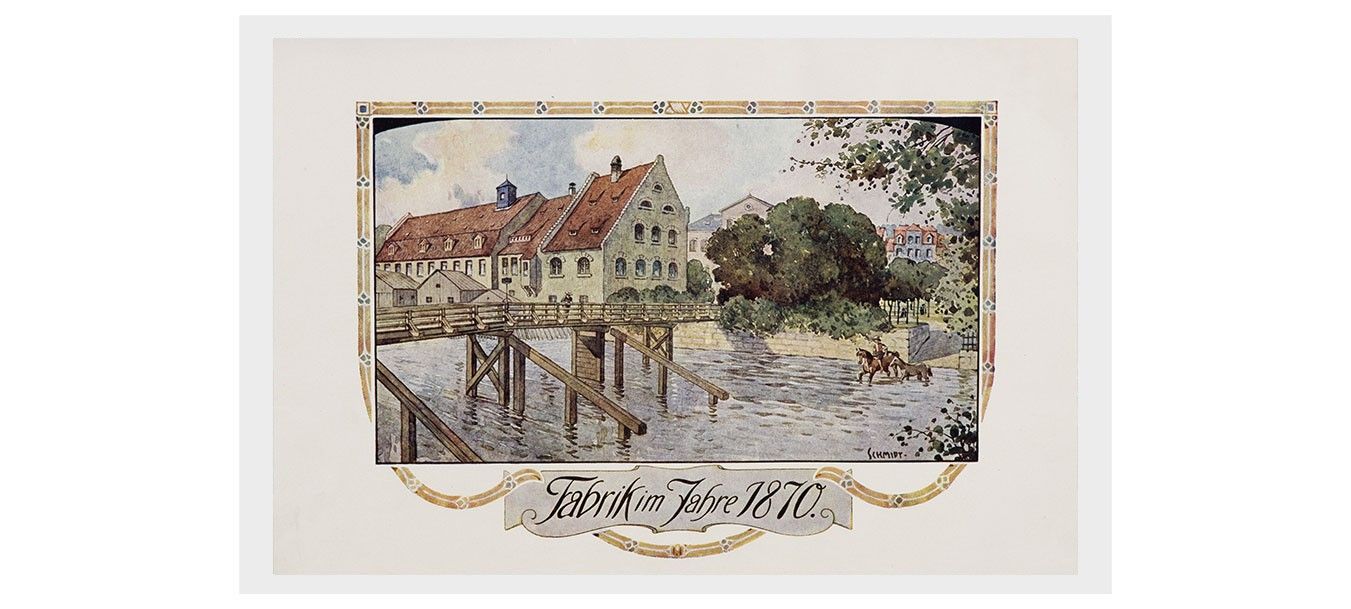
The Johann-Froescheis Lyra Bleistift Fabrik GmbH & Co. KG, as it is known today, is Nuremberg’s oldest pencil factory.
The foundations were laid in 1806 by the pencilmaker Johann Froescheis, who took over a workshop in Nuremberg and started producing pencils there. The business was run in a very modest fashion for around 40 years, operating only as a craftsman’s workshop. When Johann’s son, Georg Andreas Froescheis, took over the business in 1848, he launched the mass production of pencils. In order to cope with rising demand, Lyra moved in 1860 to the Grossweidenmühle in Nuremberg, where a water-powered mill wheel was used to start machine-assisted production.
In 1868, the LYRA symbol was registered as a trademark, something that was UNIQUE for the industry at the time. The lyre (German “LYRA”) represents the musical instrument of classical antiquity that accompanied singers of that time. We don’t know today why this particular instrument was chosen, but it is presumed that the high quality of LYRA products was associated with the qualities of the harp (a valuable instrument).
1878 was an important turning point. Andreas Froescheis gave up his position as the factory director and was succeeded by Karl Grasser. It was under his direction that the Lyra pencil factory truly began to thrive. Friedrich Froescheis’s practical experience and Karl Grasser’s commercial talent took the Lyra pencil factory into new markets. Travelling salesmen were sent out to study the business and needs of foreign countries, and to cultivate new trade relations.
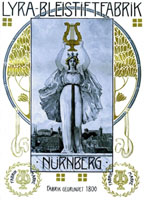
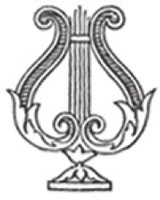
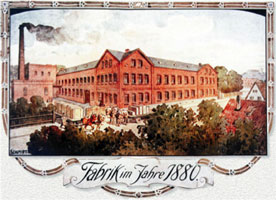
The Lyra Orlow pencil was the company’s flagship product in 1885. Alongside chalks, propelling pencils, dip pens and fountain pens, the Lyra Orlow pencil appeared with the Lyrato pencils at all of the relevant trade fairs abroad. LYRA Orlow – the German pencil industry’s greatest triumph: graphite drawing pencils in a vast array of shapes and styles, with 16 different hardnesses.
The first one-hand propelling pencil (Klimax Pocket Pencil) was produced at the Lyra pencil works in Nuremberg. What we now take for granted was a sensation at the time. Thanks to its epoch-defining design, combining mechanical and propelling systems, the Klimax was the first and only pocket pencil that could be readied for use with just one hand. It was produced in quantities that were hitherto unimaginable, and was sold both in Germany and abroad after the company had acquired a patent for it. Production was hardly able to keep pace with demand, and the Klimax was sent all over the world.
LYRA Orlow Copying Pencils were very popular at the time as they saved a lot of work in offices. They meant it was no longer necessary to write out invoices and letters multiple times. Instead, the writer used the “copying pencil”. A second, moistened sheet was placed over the document and – voilà – a copy was produced. The copy was indelible, so the pencil was also widely used for signatures. The company’s range had already been expanded to cover the needs of industry, and now included graphite chalks, lumber pencils, marking chalk and slate pencils. The 333 carpenter’s pencil – probably still the best known of its kind – was already listed under this name in a 1909 catalogue. And the company catered to artists as well, with oil pastel sticks in 60 different colours marketed under the name that they still bear today – Polycolor.
Today this all seems so simple, but at the time Johannes Grasser was a pioneer, systematically affording the export of pencils the groundbreaking role that it has today. The company’s extraordinary production achievements, growing as it has from a tiny business to a respected major enterprise, have been honoured with 9 gold medals.
Around 1900 the company had 500 employees, producing 53 million pencils and fountain pens. At this point in time, the number of registered brands had risen to seven. These included trademarks or names such as “Cleopatra”, “Taube” and “Gigerl”. The latter is equivalent in meaning to the modern word “snob”.
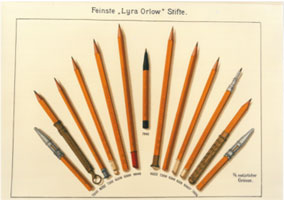
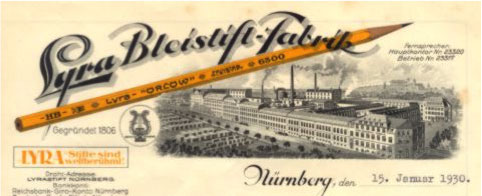
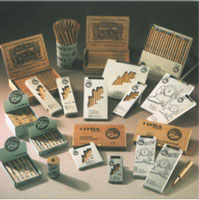
The works could have continued its upward trajectory, but this was hampered significantly by the outbreak of the First World War and inflation that followed. These difficulties were overcome, however, and the Lyra brand continued to prosper in Germany and abroad. In 1932, the company was even able to open a subsidiary pencil factory in Italy. In doing so, the company secured a kind of monopoly in that country. There was corresponding progress in Germany.
During the Second World War, however, the Lyra pencil factory works and administration buildings were reduced to ash and rubble after many bombing raids over the city of Nuremberg. The destruction rendered most of the machinery unusable. 85% of the works, used by six generations, was destroyed. But Dr Koerper – energetically supported by his son – would not be discouraged. Many old and trusted employees returned, and one position after another was reestablished. The company’s old reputation was quickly re-established, and 11 years after the chaos of war, pencils and various products from the Lyra pencil factory’s extensive range were once again available in all markets in Germany and abroad.
In 1956, Lyra – at that time still the “Lyra-Orlow pencil factory” – celebrated its 150th anniversary. In those years, its core range included graphite pencils, copying pencils, coloured pencils, special pencils, advertising pencils, clip pencils for technicians and artists, propelling and mechanical pencils, dip pens, ballpoint pens, chalks, waterproof chalks and oil pastels and, for the first time, a small selection of cosmetic pencils, too. The premium range bore the protected name of Orlow, just as it had been 80 years before. This trademark derives from the name of the most valuable and purest diamond in the former Russian crown jewels. This doubly symbolic meaning indicates the high quality of the company’s flagship product on the one hand, while also drawing attention to the fact that diamonds and graphite – one of the main raw materials for making pencils – are chemically identical, with both forms of carbon. LYRATO became known as the brand for discerning consumers.
From 1960 until the early 1980s, the product range, including the pencils, was heavily focused on technical drawing.
In order to survive tough competition in the European market, it became necessary to realign the product range. The 1980s rang in the era of innovation. In the mid-1980s the first uncoated pencils were marketed. A few years later, these became known as Pro Natura. These pencils were LYRA’s response to the growing awareness for environmental protection. They enjoyed enormous success, particularly in Germany. And they allowed Lyra to establish a unique position in the market. Shortly after that, the Color Giant conquered kindergartens. This was a thick, six-sided pencil particularly suited to small children.
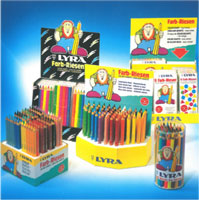
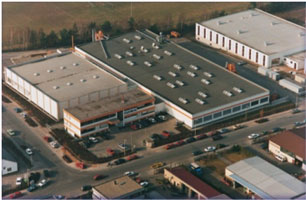
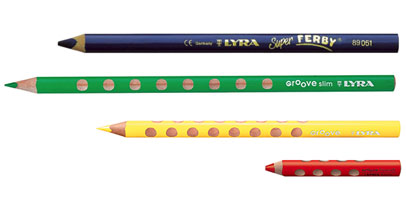
In 1987 LYRA left the site of its establishment in the centre of Nuremberg and built a new works close to the Südwestpark industrial park, with ground floor production, state-of-the-art machinery and an administration building. And that wasn’t all – other facilities were founded too: 1991 Lyra UK. In 1992, a second works started operations in Geußnitz/Zeitz (Germany). In 2000, subsidiaries were established in Singapore, Indonesia and Sweden.
In 1996 Lyra achieved groundbreaking success with the invention of the triangular pencil: with its Ferby and Super Ferby brands, Lyra laid the foundations for what remains the most popular and best-selling pencil shape in Germany. In 2008 this success was deepened – literally: the popular triangular pencils were given grooves. The “Groove” family was brought onto the market. All pencils in this brand have ergonomically-positioned grooves that help the user to position his fingers correctly.
Since 2008, LYRA has been part of the Italian group, FILA Fabbrica Italiana Lapis ed Affini S.p.A. (FILA). As an international, broad-based group, the companies benefit from synergies in manufacturing and sales. The product ranges, markets and corporate philosophy of both companies complement each other perfectly. Customers all over the world benefit from a more extensive product range and competitive prices. Based on the principle of “quality in tradition and innovation in conviction”, more than 14 million wood-cased pencils are now produced annually at the over 6,400-square metre production area in Nuremberg and exported throughout the world. LYRA has a total workforce of around 100 employees in Nuremberg. LYRA’s core expertise lies in the production and sale of wood-cased writing implements. The company also sells items for the office, home crafts and hobby sectors, as well as products for industry.

